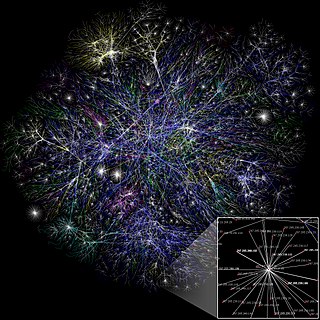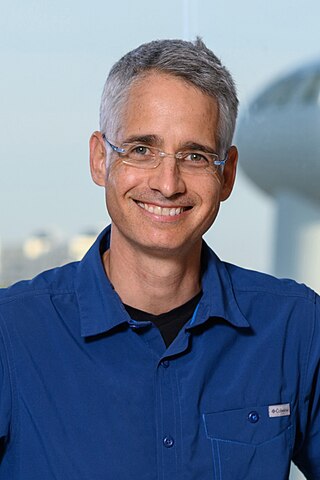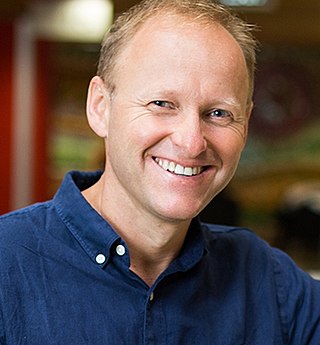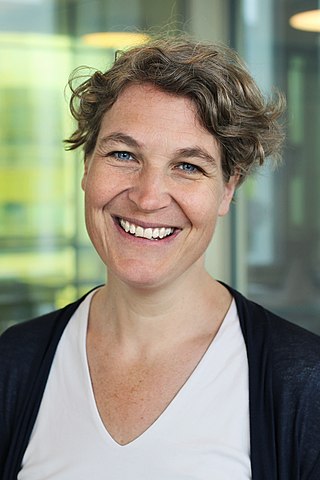
A generegulatory network (GRN) is a collection of molecular regulators that interact with each other and with other substances in the cell to govern the gene expression levels of mRNA and proteins which, in turn, determine the function of the cell. GRN also play a central role in morphogenesis, the creation of body structures, which in turn is central to evolutionary developmental biology (evo-devo).

In biology, an effector is a general term that can refer to several types of molecules or cells depending on the context:

Network motifs are recurrent and statistically significant subgraphs or patterns of a larger graph. All networks, including biological networks, social networks, technological networks and more, can be represented as graphs, which include a wide variety of subgraphs.

Mitogen-activated protein kinase kinase kinase 1 (MAP3K1) is a signal transduction enzyme that in humans is encoded by the autosomal MAP3K1 gene.
BioNumbers is a free-access database of quantitative data in biology designed to provide the scientific community with access to the large amount of data now generated in the biological literature. The database aims to make quantitative values more easily available, to aid fields such as systems biology.
The International Human Frontier Science Program Organization (HFSPO) is a non-profit organization, based in Strasbourg, France, that funds basic research in life sciences. The organization implements the Human Frontier Science Program (HFSP) and is supported by 14 countries and the European Commission. Shigekazu Nagata is the HFSPO President and Chair of the Board of Trustees since 2018.
Michael B. Elowitz is a biologist and professor of Biology, Bioengineering, and Applied Physics at the California Institute of Technology, and investigator at the Howard Hughes Medical Institute. In 2007 he was the recipient of the Genius grant, better known as the MacArthur Fellows Program for the design of a synthetic gene regulatory network, the Repressilator, which helped initiate the field of synthetic biology. He was the first to show how inherently random effects, or 'noise', in gene expression could be detected and quantified in living cells, leading to a growing recognition of the many roles that noise plays in living cells. His work in Synthetic Biology and Noise represent two foundations of the field of Systems Biology. Since then, his laboratory has contributed to the development of synthetic biological circuits that perform a range of functions inside cells, and revealed biological circuit design principles underlying epigenetic memory, cell fate control, cell-cell communication, and multicellular behaviors.
Systems medicine is an interdisciplinary field of study that looks at the systems of the human body as part of an integrated whole, incorporating biochemical, physiological, and environment interactions. Systems medicine draws on systems science and systems biology, and considers complex interactions within the human body in light of a patient's genomics, behavior and environment.

Hermona Soreq is an Israeli professor of Molecular Neuroscience at The Hebrew University of Jerusalem. Best known for her work on the signaling of acetylcholine and its relevance in stress responses and neurodegenerative diseases such as Parkinson's and Alzheimer's.
Akhilesh Reddy is a British physician-scientist. He completed the MB/PhD program at the University of Cambridge where he received a PhD from the MRC Laboratory of Molecular Biology. He previously was a Wellcome Trust Senior Fellow in Clinical Sciences at the University of Cambridge. He is currently an associate professor of pharmacology at the University of Pennsylvania.
Pulsatile secretion is a biochemical phenomenon observed in a wide variety of cell and tissue types, in which chemical products are secreted in a regular temporal pattern. The most common cellular products observed to be released in this manner are intercellular signaling molecules such as hormones or neurotransmitters. Examples of hormones that are secreted pulsatilely include insulin, thyrotropin, TRH, gonadotropin-releasing hormone (GnRH) and growth hormone (GH). In the nervous system, pulsatility is observed in oscillatory activity from central pattern generators. In the heart, pacemakers are able to work and secrete in a pulsatile manner. A pulsatile secretion pattern is critical to the function of many hormones in order to maintain the delicate homeostatic balance necessary for essential life processes, such as development and reproduction. Variations of the concentration in a certain frequency can be critical to hormone function, as evidenced by the case of GnRH agonists, which cause functional inhibition of the receptor for GnRH due to profound downregulation in response to constant (tonic) stimulation. Pulsatility may function to sensitize target tissues to the hormone of interest and upregulate receptors, leading to improved responses. This heightened response may have served to improve the animal's fitness in its environment and promote its evolutionary retention.
Nicolas Le Novère is a British and French biologist. His research focuses on modeling signaling pathways and developing tools to share mathematical models.

Ron Milo is a Professor of Systems Biology at the Weizmann Institute of Science. He is Weizmann Dean of Education, the chairperson of the Israel society of ecology and environmental sciences and the director of the institute for environmental sustainability at Weizmann. Formerly he was the chairperson of the Israeli young academy and the science and technology committee in the ministry of education of Israel.
Alexander Stark is a biochemist and computational biologist working on the regulation of gene expression in development. He is a senior scientist at the Research Institute of Molecular Pathology (IMP) at the Vienna Biocenter and adjunct professor of the Medical University of Vienna.

Coiled-coil domain containing 74A is a protein that in humans is encoded by the CCDC74A gene. The protein is most highly expressed in the testis and may play a role in developmental pathways. The gene has undergone duplication in the primate lineage within the last 9 million years, and its only true ortholog is found in Pan troglodytes.

Hanah Margalit is a Professor in the faculty of medicine at the Hebrew University of Jerusalem. Her research combines bioinformatics, computational biology and systems biology, specifically in the fields of gene regulation in bacteria and eukaryotes.

Galit Lahav is an Israeli-American systems biologist and Professor of Systems Biology at Harvard Medical School. In 2018 she became Chair of the Department of Systems Biology at Harvard Medical School. She is known for discovering the pulsatile behavior of the tumor suppressor protein p53 and uncovering its significance for cell fate, and for her contributions to the culture of mentoring in science. She lives in Boston, Massachusetts.

Alex Sigal is a South Africa–based virologist at the Africa Health Research Institute (AHRI) in Durban, South Africa, Max Planck Institute for Infection Biology in Berlin, and University of KwaZulu-Natal in Durban. His work concentrates on evolution and persistence of the SARS-CoV-2 virus. His laboratory was the first to isolate the live B.1.351 (Beta) variant of SARS-CoV-2 first detected in South Africa. Sigal’s laboratory was also the first to report results on the ability of the Omicron variant to escape antibody neutralization in individuals who had two doses of the Pfizer BNT162b2 vaccine as well as from previous infections, with results also suggesting that vaccination combined with a booster or previous infection can offer protection from symptomatic infection with Omicron.

Andrea Pauli is a developmental biologist and biochemist studying how the egg transitions into an embryo, and more specifically the molecular mechanisms underlying vertebrate fertilisations, egg dormancy, and subsequent egg activation. Her lab uses zebrafish as the main model organism. Andrea Pauli is a group leader at the Research Institute of Molecular Pathology (IMP) at the Vienna Biocenter in Austria.
In the area of system identification, a dynamical system is structurally identifiable if it is possible to infer its unknown parameters by measuring its output over time. This problem arises in many branch of applied mathematics, since dynamical systems are commonly utilized to model physical processes and these models contain unknown parameters that are typically estimated using experimental data.











